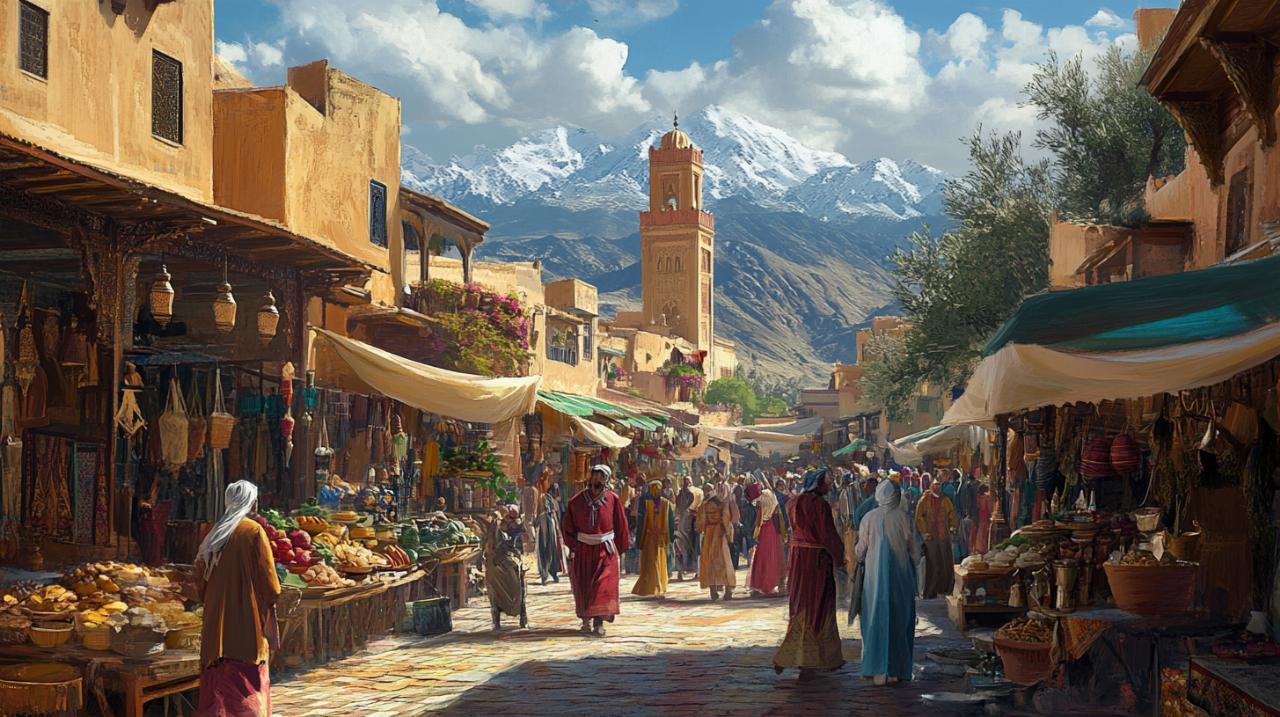Tucked away between the rugged peaks of the Rif Mountains and the sweeping expanse of the Middle Atlas, Taza stands as one of Morocco's most authentic yet often overlooked treasures. This fortified city, with roots stretching back to the seventh century, occupies a strategic mountain corridor known historically as the Taza Gap. Far removed from the well-trodden tourist circuits, Taza offers visitors a rare opportunity to experience Morocco's architectural heritage and vibrant local culture in an atmosphere that remains refreshingly genuine. The old medina, perched at an elevation of around five hundred and fifty metres, presents a captivating tapestry of narrow alleyways, time-worn stonework, and traditional Moroccan life that continues much as it has for generations.
The ancient medina: a journey through time-worn streets
Architectural heritage within the city walls
Wandering through the ancient medina of Taza is akin to stepping into a living museum where history whispers from every corner. The fortified walls that encircle this elevated quarter have stood sentinel over the surrounding valleys for centuries, their weathered stones bearing witness to the passage of countless travellers, traders, and conquerors. The medina's layout reflects the traditional Islamic urban design, with its labyrinthine streets deliberately narrow and winding to provide shade during scorching summers and protection from harsh winds in winter. Buildings here showcase the distinctive features of Moroccan architecture, from intricately carved wooden doors to ornate zellige tilework that adorns doorways and fountains. The compact nature of the medina means that exploration on foot is not merely recommended but essential, allowing visitors to discover hidden courtyards, ancient water cisterns, and beautifully preserved examples of residential architecture that date back several centuries. The oldest sections of the medina retain much of their original character, with homes constructed from local stone and timber that have weathered gracefully over time.
Traditional souks and artisan quarters
The souks of Taza offer an authentic glimpse into the commercial heart of traditional Moroccan life, far removed from the tourist-oriented markets found in larger cities. Thursday serves as the principal market day, when the medina comes alive with vendors from surrounding villages bringing their produce, livestock, and handcrafted goods to trade. The artisan quarters within the old town continue to practice crafts that have been passed down through generations, from leather working to metalworking and textile weaving. Walking through these districts, visitors can observe skilled craftsmen at work, fashioning traditional items using techniques that have remained largely unchanged for centuries. The souks also provide an opportunity to sample local specialities, including the renowned Taza honey and olive oil, both of which benefit from the region's unique microclimate and fertile soil. Unlike more commercialised medinas, the souks here maintain their function as genuine community marketplaces where locals conduct their daily shopping, creating an atmosphere of authenticity that proves increasingly rare in modern Morocco.
The grand mosque: testament to taza's islamic legacy
Intricate zellige tilework and carved cedar details
The Great Mosque of Taza, constructed during the twelfth century, stands as perhaps the most significant architectural landmark within the historic quarter. This magnificent structure exemplifies the sophisticated craftsmanship of Moroccan Islamic architecture, with every surface displaying meticulous attention to detail. The zellige tilework, created using thousands of hand-cut ceramic pieces arranged in complex geometric patterns, adorns the mosque's courtyard and prayer halls in dazzling displays of colour and mathematical precision. These mosaics represent not merely decoration but a profound expression of Islamic art, where geometric patterns symbolise the infinite nature of divine creation. Equally impressive are the carved cedar details found throughout the building, particularly in the ceiling beams and the minbar, or pulpit. Cedar from the nearby Middle Atlas forests has been transformed by master craftsmen into intricate arabesques and calligraphic inscriptions, their rich amber tones deepening with age. The mosque's minaret, visible from many vantage points across the old town, rises above the surrounding rooftops as a constant reminder of Taza's enduring Islamic heritage.
Historical significance in moroccan architecture
Beyond its aesthetic merits, the Great Mosque holds considerable historical importance within the broader context of Moroccan architectural development. Built during a period when Taza served as a crucial stronghold along the route connecting Fez to the east, the mosque reflects both the city's strategic importance and its role as a centre of religious scholarship. The architectural style represents a transitional phase between earlier Maghrebi traditions and the more elaborate forms that would later characterise Moroccan religious buildings. Elements of the mosque's design influenced subsequent constructions throughout the region, making it a key reference point for scholars studying the evolution of Islamic architecture in North Africa. The building has undergone various restorations over the centuries, yet it retains much of its original character, offering contemporary visitors a genuine connection to medieval Morocco. The preservation of such structures proves essential not only for historical documentation but also for maintaining the cultural identity of communities like Taza, where architectural heritage remains inseparable from daily life and religious practice.
Beyond the Quarter: Natural Wonders and Cave Systems
Gouffre friouato: north africa's geological marvel
 Venturing beyond the historic quarter reveals a landscape of extraordinary natural beauty, with the Gouffre Friouato caves ranking among the most spectacular geological formations in North Africa. This extensive cave system, with the Rhar Chara Cave extending approximately seven and a half kilometres into the mountain, offers adventurous visitors an unforgettable subterranean experience. The descent into the caves begins with a dramatic staircase cut into the rock, leading down into a vast underground chamber where stalactites and stalagmites have formed over millennia into surreal sculptures. The constant temperature of around fifteen degrees Celsius provides welcome relief during summer months whilst feeling surprisingly mild in winter. The caves require a reasonable level of fitness to explore properly, as the descent involves navigating steep steps and uneven surfaces, but the reward is witnessing one of nature's most impressive displays. Local guides are available to lead tours through the accessible portions of the cave system, sharing knowledge about the geological processes that created these formations and the various species of bats and other creatures that inhabit the darkness.
Venturing beyond the historic quarter reveals a landscape of extraordinary natural beauty, with the Gouffre Friouato caves ranking among the most spectacular geological formations in North Africa. This extensive cave system, with the Rhar Chara Cave extending approximately seven and a half kilometres into the mountain, offers adventurous visitors an unforgettable subterranean experience. The descent into the caves begins with a dramatic staircase cut into the rock, leading down into a vast underground chamber where stalactites and stalagmites have formed over millennia into surreal sculptures. The constant temperature of around fifteen degrees Celsius provides welcome relief during summer months whilst feeling surprisingly mild in winter. The caves require a reasonable level of fitness to explore properly, as the descent involves navigating steep steps and uneven surfaces, but the reward is witnessing one of nature's most impressive displays. Local guides are available to lead tours through the accessible portions of the cave system, sharing knowledge about the geological processes that created these formations and the various species of bats and other creatures that inhabit the darkness.
Parc national de tazzeka's scenic landscapes
The Tazekka National Park encompasses one hundred and thirty-seven square kilometres of diverse terrain, from dense cedar forests to rocky peaks and cascading waterfalls. At its heart stands Jbel Tazekka, rising to nearly two thousand metres and offering panoramic views across the surrounding region on clear days. The park provides numerous hiking trails suitable for various fitness levels, from gentle walks through shaded woodlands to more challenging ascents towards the summit. Spring months from March to May transform the park into a botanical wonderland, with wildflowers carpeting the meadows and streams running full from winter rains. Autumn, spanning September through November, offers equally pleasant conditions with comfortable temperatures ranging between fifteen and twenty-eight degrees Celsius, making it ideal for extended outdoor exploration. The park's cedar forests shelter diverse wildlife, including Barbary macaques, wild boar, and numerous bird species, though sightings require patience and quiet observation. For visitors with access to a vehicle, the park's scenic routes provide spectacular drives with frequent viewpoints overlooking valleys and distant mountain ranges.
Experiencing authentic taza: culture and local life
Traditional moroccan hospitality and cuisine
Taza's relative remoteness from major tourist centres has preserved a genuine warmth in local hospitality that can feel increasingly rare in more commercialised destinations. Staying in a traditional riad within the medina offers the most immersive cultural experience, with guesthouses typically costing between four hundred and eight hundred dirhams per night. These restored historic homes feature the classic Moroccan architectural elements of interior courtyards, decorative tilework, and carved plaster, whilst providing comfortable modern amenities. The local cuisine deserves particular attention, with Taza claiming several distinctive specialities. Rfissa, a celebratory dish combining tender chicken and lentils served over layers of thin pancakes soaked in rich broth, represents the pinnacle of regional cooking. The area's honey, produced from wildflowers in the surrounding mountains, possesses a distinctive flavour profile that has earned recognition throughout Morocco. Similarly, the olive oil pressed from groves in nearby valleys displays exceptional quality. Restaurants and street vendors throughout the medina and new town offer tagines and other Moroccan classics at remarkably reasonable prices, typically ranging from thirty to one hundred dirhams per meal.
Practical tips for visiting taza's historic sites
Planning a visit to Taza requires consideration of several practical factors to ensure a smooth and rewarding experience. The city benefits from reasonable transport connections, with train services linking it to Fez in approximately two hours, Oujda in three hours, and Casablanca in five hours. The N6 highway provides straightforward driving access for those travelling by car, whilst CTM and Supratours operate regular bus services. Within Taza itself, the small blue taxis known as petit taxis offer convenient and inexpensive transport between the elevated medina and the newer town in the valley below. Hotels in the ville nouvelle typically cost between three hundred and six hundred dirhams nightly, providing comfortable bases for exploration. Budget travellers can find guesthouse accommodation starting around one hundred and fifty dirhams. The Kasbah Museum, housed within the old fortifications, presents an informative overview of Taza's history through displays of artefacts and exhibits. Visitors should note that whilst Arabic serves as the official language, French is widely spoken and proves useful for communication. The Moroccan dirham remains the local currency, with ATMs available in the new town. Avoiding the extreme heat of summer, when temperatures regularly exceed thirty-five degrees, and the cooler, wetter winter months ensures the most comfortable visit to this remarkable historic city.

